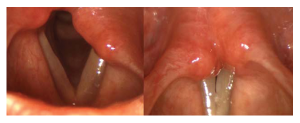The vocal folds in abduction and during phonatory adduction on rigid strobolaryngoscopic examination. Most examiners found a left-sided (97%) paresis involving the recurrent laryngeal nerve (74%). Examiners indicated decreased VF abduction, slow/sluggish VF movement, and decreased VF adduction as the most compelling clinical findings in diagnosis.
Credit: © The American Laryngological, Rhinological and Otological Society, Inc.
The vocal folds in abduction and during phonatory adduction on rigid strobolaryngoscopic examination. Most examiners found a left-sided (97%) paresis involving the recurrent laryngeal nerve (74%). Examiners indicated decreased VF abduction, slow/sluggish VF movement, and decreased VF adduction as the most compelling clinical findings in diagnosis. Credit: © The American Laryngological, Rhinological and Otological Society, Inc.
ENTtoday - https://www.enttoday.org/article/strobolaryngoscopy-common-diagnostic-vocal-fold-paresis-clinical-signs-vary/ent_0917_pg9a/
